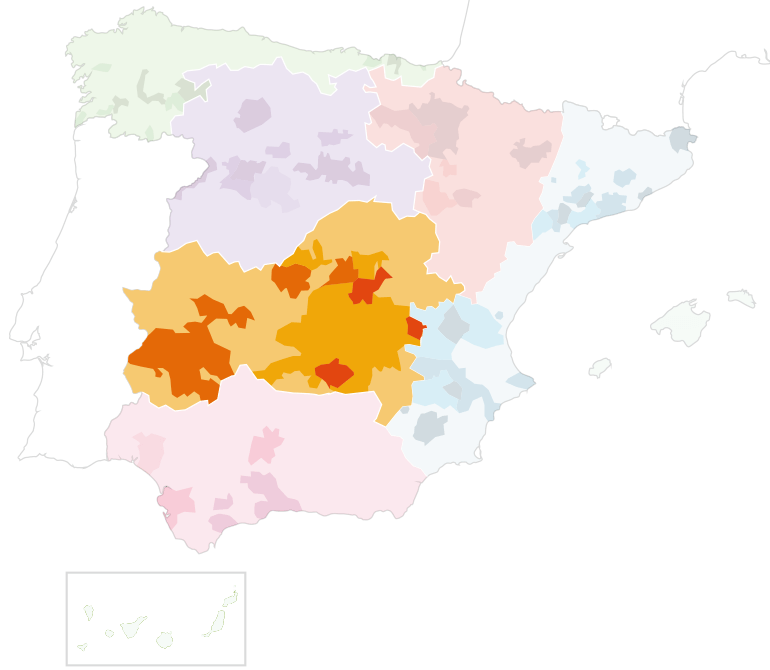You are here

The Meseta
Almost two-thirds of all Spain’s vineyards are on these arid plains. Until just a decade or two ago, it was an internationally accepted dictum that little of quality was made here. How wrong we all were. Many of Spain’s top Vinos de Pago (such as Dominio de Valdepusa, Finca Elez, Dehesa de Carrizal and Pago Guijoso) are found in this area. The northern portion of the Meseta pitches its dry plateau to the edges of the Sistemas Central and Ibérico; the vineyards might be hot and dry, but they often lie at high altitudes, and nighttime temperatures can be cool as a result.
The Castilla–La Mancha region is the Midi of Spain, and as with France’s Midi, a focus upon varietals is fueling a revolutionary turnabout. But the revolution is still nascent. For the moment, Airén remains the most widely planted grape, at over 70 percent of the vineyards. Within this larger region is the absurdly large DO La Mancha, and nearly half of the vineyards of the DO aren’t allowed to use the DO on their label. Confused? Don’t be; it speaks well of the DO rules that merely being from an area doesn’t guarantee a producer its DO status.
Almansa's 7,200 hectares of vineyards are watched over by the town's splendid castle, which looks out over south-eastern Albacete province.
The Monastrell grape is just beginning to show its tremendous potential here, as elsewhere in Valencia, and wine-making styles are beginning to develop slowly along similar lines. As in other neighbouring denominations, the pioneering bodegas' new red wines, blending Monastrell with Tempranilo, are finding a place in export markets.
Located in the southern Castilian meseta, some 60 km from Madrid, La Mancha is Spain’s largest denomination of origin, occupying 30,700 km², and accounting for half of the land area of the provinces it encompasses.
The vineyards fall in 182 municipalities: 12 in the province of Albacete, 58 in Ciudad Real, 66 in Cuenca and 46 in Toledo, although certain modifications are underway to exclude areas that are not up-to-date on their registration.
Although Manchuela’s full DO status was confirmed only in July 2000 and its regulation in June 2004, it had been defined and regulated as a DOP since 1982, when it split off from DO La Mancha.
This is good red-wine country, with influences from the surrounding DOs – there are some doble pasta (musts fermented over two batches of lees to give big red wines) and La Mancha style whites - and it shows promise for the coming years, especially given the new spirit of experiment in certain bodegas. Already the shift from providing bulk wines for blending elsewhere to bottled wines recognized with their own identity is having certain repercussions.
Méntrida, an old but little known winemaking area, lies in the northwest of the province of Toledo. Nowadays, it is beginning to show its potential.
Local producers have acquired stainless steel equipment to complement the grapes, soil and climate, and produce good modern wines.
Mondéjar, upgraded in 1997 from Vinos de la Tierra, is situated in the province of Guadalajara and covers an area of 500 hectares.
The vineyards are spread over low, hilly country north-east of Madrid, but most are clustered around the town after which the DO is named. The DO also incorporates eighteen other towns, one of which is Sacedón. Production is small, but already there are distinctive and interesting DO wines, particularly the reds, which are drunk young.
This young denomination in south-eastern Cuenca province was granted DO status in 2003.
Unusually the red wines, intense and with a marked personality, are certified not by the DO’s own tasting panel, but by the Instituto del Vino de Castilla La Mancha. Most producers are cooperatives, although there are also a private bodega. More than half of its wines are produced for export.
It is obvious, with a simple tour of the region, that this area of wine production has environmental, climate, and soil conditions different from the typicall wine producing regions of La Mancha.
It has an heterogeneity of the relief and depth variability of soils and climatic conditions that do not coincide with the southern part of the Spanish plateau.
The vines of Valdepeñas DO are located at the south of Castile- La Mancha, among the south of Spain, the Mediterranean regions, Extremadura and the central plateau. With a long wine production history, this Denomination has a unique style.
Since many Airén grapevines were planted after phylloxera destroyed the vineyards here in 1911, Valdepeñas created its own personal style.
Extremadura's first DO takes its name from the river that runs east to west through its vineyards. The DO Ribera del Guadiana groups six sub-zones distributed between the region’s two provinces: Badajoz to the south, and Cáceres to the north.
Today the area shows evidences of a decisive belief in the modernisation of viticulture and oenology. At the same time each producer continues to preserve his or her own style. As a result, there has been an exceptional improvement in both the red and white wines made here.
In summer of 1990 the wine region of Madrid, located to the southeast and southwest of the city, got the DO status. Since then, great efforts have been done to raise quality and knowledge of the wines produced here.
Vineyards are located in 54 municipalities, plus the experimental state of El Encín in Alcalá de Henares. The DO is divided in three subzones: Arganda, Navalcarnero and San Martín, where styles may vary from one to another. In the last years both wineries and the Regulating Council have been doing promotional campeigns to extend the image of Vinos de Madrid in the national and, especially, in the international market.








